I "Cut the Cord" I no longer have satellite TV
In the mid 1990's, I purchased one of the very early DirectTV satellite systems using a small round 18 inch diameter dish. Since that time I have continuously had a satellite subscription to initially supplement cable TV and later, totally replace it. Satellite was particularly good for me, as I had a receiver in each of the motor homes I had over the years, and was able to receive my full array of TV programs where ever I traveled.
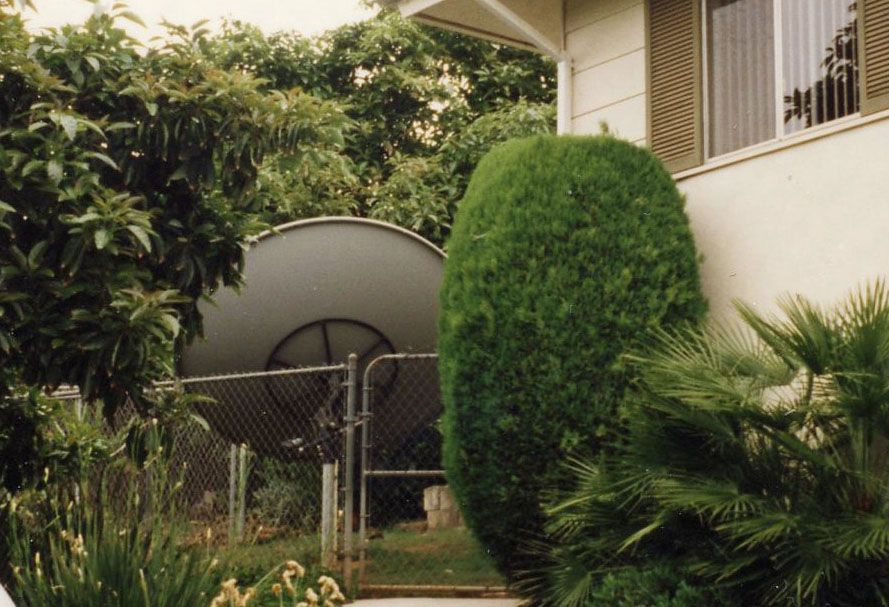
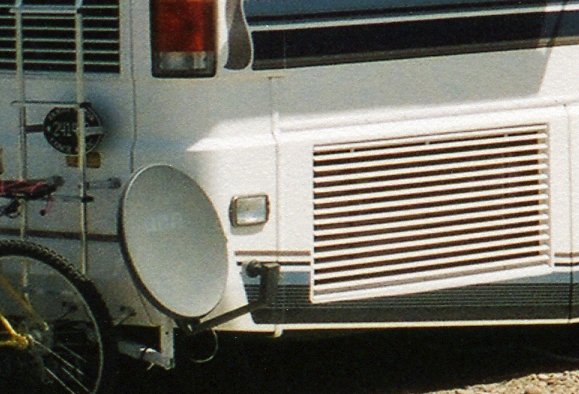
My first satellite receiver used an 8 foot diameter dish, shown on the left. Later ones used an 18 inch dish as shown on the right attached to the right rear corner
of our motor home.
Initially I was loyal to DirectTV until after moving to Arizona I inquired about expanding it to my full house and dropping my cable TV. As an existing customer they wanted $500 for the equipment they would give me free if I were a new customer. I canceled DirectTV and subscribed with Dish TV and was very happy with them for the next 18 years. About 3 weeks ago, as I write this in mid-August 2023, I canceled Dish!
There are several reasons I decided to cut the (virtual) cord:
- I no longer have a motor home, so portability is no longer a priority.
- I find I am watching less and less on satellite, and more on streaming video channels
- The price was getting far too high, especially considering my decreasing usage
Replacing Satellite TV:
I had researched my options and decided that one approach which would reduce the cost somewhat and limit my obligation to 1 month at a time was YouTubeTV. At about $73 per month it was far less than the $135 Dish now wanted and somewhat less than if I again managed to re-negotiate the price - a process I detest!. I received a 10 day free trial, and then bought 1 month of YouTubeTV. This is as close a package as I can find to simply replacing a cable TV or satellite plan. It offers all the local networks, some sports channels, and a bunch of the normal cable channels. It offers an unlimited content on-line DVR and will save any of your content for 9 months before deleting it. It seems to be a well polished and quite complete plan.
Unfortunately it suffers exactly the same problem I had with Dish, just to a lesser extent: It is still quite expensive, and it includes all the channels I am now watching less. It turns out that two components of these plans are the most expensive. Local channels, which you can receive free with an antenna are quite expensive on a re-transmission service along with the sports channels. An article I just read states that if your plan includes ESPN, then about $15 a month of your service fee goes to pay for that 1 channel! I am not a sports enthusiast and I can get the locals for free if I put up a suitable antenna. I have a plan!
Installing a TV Antenna:
Two or 3 years ago, I bought a cheap TV antenna strictly to test whether I could receive any useful channels from the TV repeaters on Mingus Mountain, about 20 miles from here. The antenna had a built-in rotator and pre-amp. Connected to my living room TV, it brought in about 40 channels. I was amazed. I bought this antenna only because it was cheap, and it had good reviews for performance, but poor reviews for reliability. Sure enough on the 2nd day I had it installed, the rotor stopped working, but I had already found the direction I needed, so no big deal. I only occasionally tried the antenna after that, as it was premature to actually change over. Recently I tried it and received 1 channel! Apparently the pre-amp is now dead also, which renders the antenna useless.
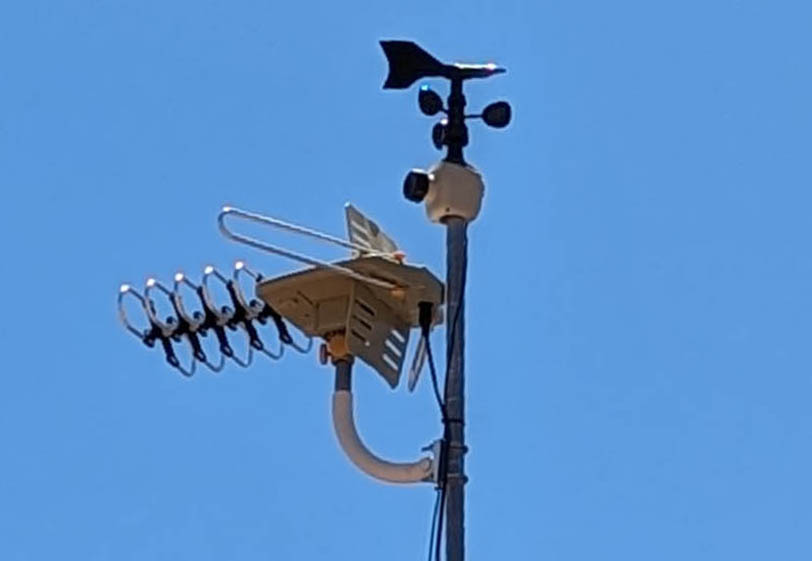
My old (crummy) antenna is mounted on my weather station mount.
Knowing that I can receive many channels over the air (OTA) I decided to install a quality antenna and go ahead with my cord cutting plans. On Amazon's Prime days, I bought a DVR for OTA broadcasts and shortly later I bought a Channel Master medium range antenna which includes low VHF capabilities. As very few stations are still broadcasting on TV channels 1 through 6 (low VHF), most current antennas are UHF (channels 14 through 65) and sometimes also include high VHF (channels 7 through 13). Many local neighbors with rooftop antennas complain that they cannot receive NBC, which is unfortunate enough to have been assigned channel 6.
At my current age, my son seems to think that I should no longer be climbing around on my roof, (and I somewhat agree with him). To avoid working any higher than a step ladder safely allows (I bought a new 8 foot step ladder to allow this), I designed a mount for the antenna that attaches to the wall of the house, has a pivoting mounting arm which allows the antenna to be mounted and mostly aligned from the ground. When all is ready, the pole is pivoted upright, a bolt is inserted through a pair of matching holes and the antenna is up.
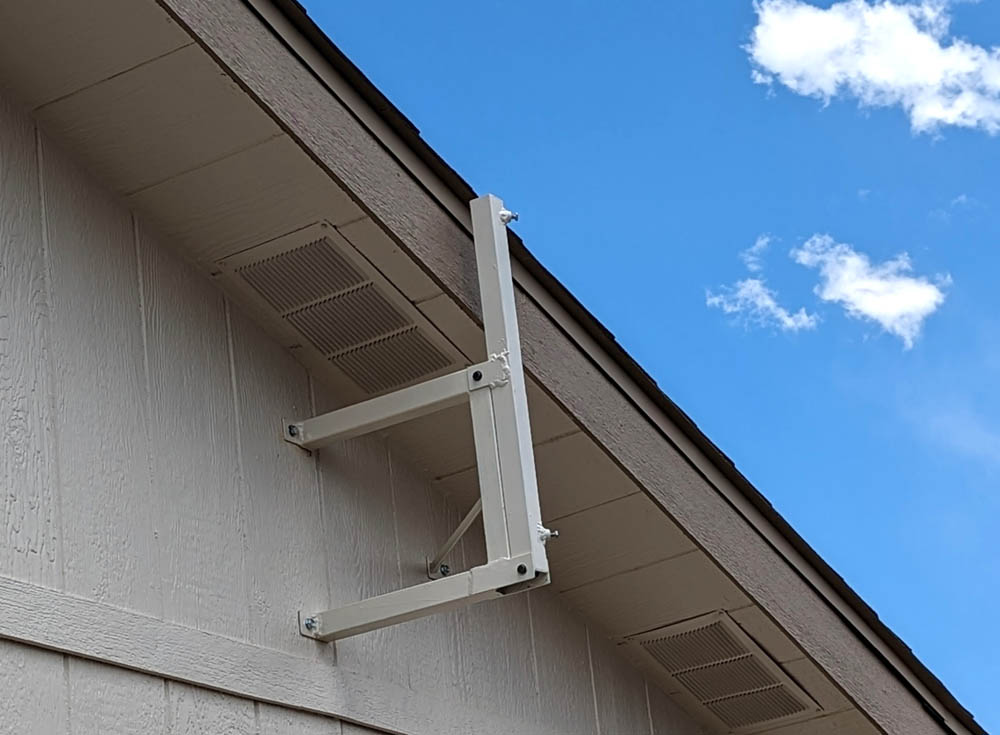
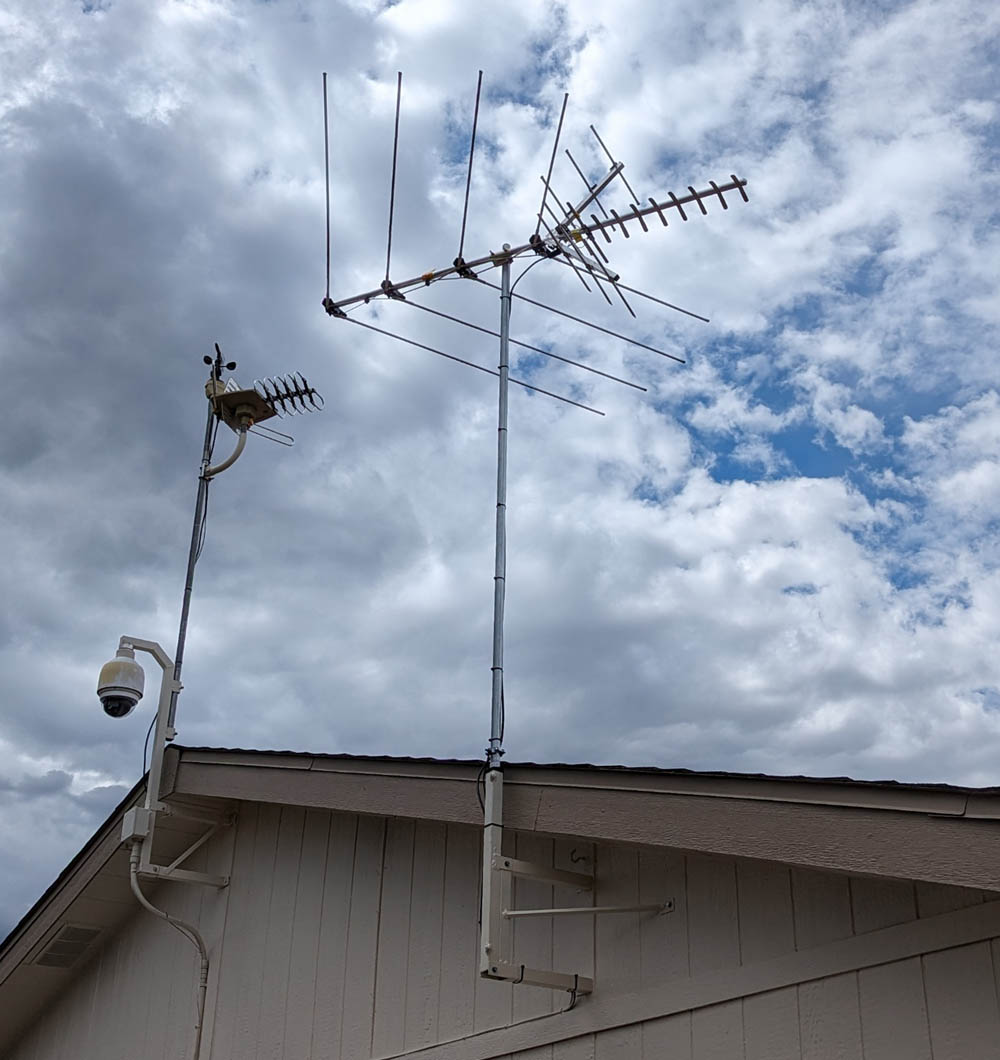
The mount is welded steel tubing. The long vertical piece pivots down so the antenna mast can be reached from the ground. All the mounting, wiring,
zip-ties etc. was done, then the whole assembly was tilted upright and secured with a 1/4 inch bolt. The right picture shows the completed installation
(including the old antenna, the removal of which requires more climbing than I am willing to do). The antenna is as large as it is due to being designed
for all the bands, including low VHF. I get NBC beautifully, a channel most of my neighbors with antennas cannot get.
My current viewing habits consist mostly of watching the news on local channels real time, along with mostly on-demand streaming channels. I also watch a few programs from the satellite that I have my DVR set to record, which I then watch at my convenience (I really only end up watching some of them). Occasionally, I just channel hop to see what might be interesting. I hope to continue pretty much the same after discontinuing my Dish service.
After quite a bit of research into the various streaming channels and what each provides, along with the cost of each one, I have decided that for my live TV I can use my antenna. For other programs broadcast over the local channels I can also use the antenna and record the programs on my OTA DVR, a Tablo Dual Lite. To supply the few programs I want to watch on the so called Cable channels I chose to subscribe to Philo. This is a service which streams over 100 channels and includes all the ones I decided I still want. These were the Discovery channel, the various Hallmark channels, the Science channel, HGTV, and the DIY channel (now Magnolia), etc. Philo includes these and most of the other popular non-sports channels. I enjoy many of these other channels occasionally when I just want to "channel surf". The service includes an on-line DVR and many of the programs I am interested in are offered on-demand for a wide range or all of their seasons. One of my favorite shows, and of which I had been building a library on my Dish DVR is Battlebots. I was sorry to lose my library when I gave up Dish. Now all those episodes are available on demand on my Philo service. My monthly $25 Philo bill is my only cost to replace my Dish $100 (as negotiated) to $135 monthly bill. My primary other costs, which I still had along with Dish, are for Netflix and Prime Video, which is part of my Amazon Prime account.
A real advantage of transferring to the streaming channels is that I can change my selection on a monthly basis. - NO CONTRACTS! It is simple to cancel one service and subscribe to another. Subscribe to one, watch the content you are most interested in and when you tire of it or a particular series ends, cancel and go with another. This way you can watch the best of many services without ever paying for more than one or two at a time.
My Tablo Over-the_Air DVR:
The thing that really makes TV from my antenna practical for me (and my thoroughly spoiled by TV Digital Video Recorders mentality) is my Tablo OTA DVR! I bought this unit, based only on the reviews I had read, from Amazon during their Prime Days. It was discounted 33% and to me was a "no brainer". This box performs several functions:
- It is my Over-the-Air TV receiver and only connection to my antenna.
- It is my OTA video distribution system to my various receivers, phones, and tablets via my home Internet.
- It is my means of recording and playing back these programs.
- It provides a 14 day TV guide for the OTA programs.
- As it streams to each TV, no special remote is required. Each TV uses the same remote as for all its other streaming channels.
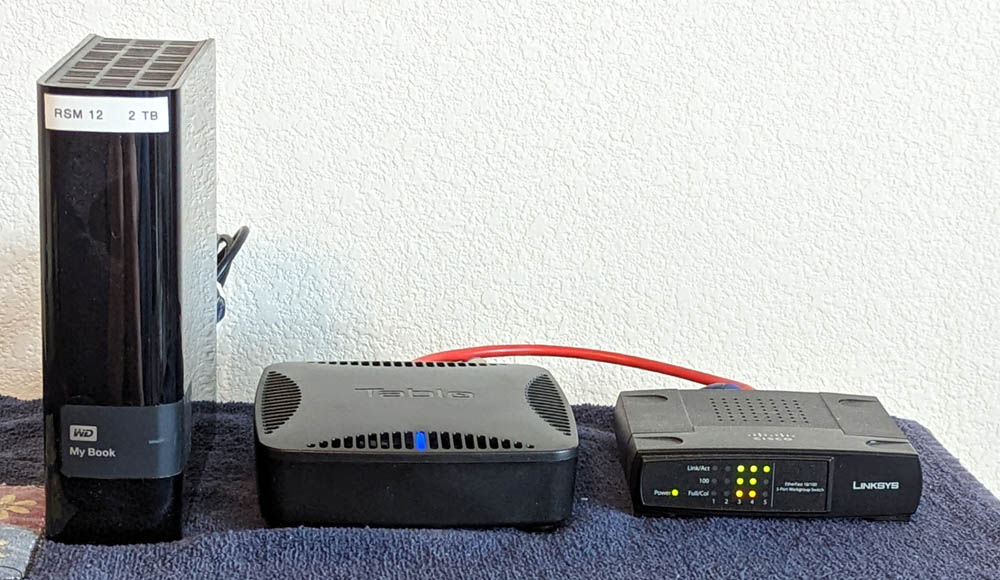
This is my Tablo setup. It is in my bedroom where the antenna connection comes into the house
behind this cabinet, and is why I located it here. To the left is the external hard drive where all the
recorded content is stored. A smaller drive would work just as well, but this one was available.
The center is the Tablo box. To the right is a network switch. It takes the single Ethernet cable
feeding this side of the bedroom and splits it to feed both the Tablo and the TV above. I need to
tape over the lights as they are quite bright at night!
In operation, the box connects to my antenna, receives all the
channels, formats a TV guide, provides for recording and playing back
the desired programs, creates the user interface, and then sends it out
out over my local network as though it were just another streaming
channel. Any TV or other device that can stream connects to my
network and through a Tablo provided app, can play the content just as
Netflix, Prime Video or any other streaming channel. There is no
need to run TV coax throughout the house using splitters etc. As
long as the device has a network connection through Ethernet or WiFi,
it will work. The Tablo unit can be located anywhere. It
does not need to be close to a TV. In fact it is good to locate
it close to the antenna to minimize the coax line losses. Once
the
signal passes through the Tablo, network cables or WiFi distances have
no effect on the quality of the TV signal. Some people even
locate their Tablos in the
attic.behind this cabinet, and is why I located it here. To the left is the external hard drive where all the
recorded content is stored. A smaller drive would work just as well, but this one was available.
The center is the Tablo box. To the right is a network switch. It takes the single Ethernet cable
feeding this side of the bedroom and splits it to feed both the Tablo and the TV above. I need to
tape over the lights as they are quite bright at night!
There is one major disadvantage to the Tablo that about half the other OTA DVRs share: It requires a subscription for full functionality! Without the subscription, there is a 24 hour guide and you can record from it by selecting a single show, or record manually like with an old VCR, inputting starting time, length of recording, and channel. But to select a series or repeated program to record, or to do several of the more exotic functions available, you need the full 14 day guide. This costs $5 a month or $50 a year. I guess my $100 purchase price cannot support the continuing cost of creating and updating this guide, but I really do not like it! I tried a competing unit which does not charge for the guide and cost about the same as Tablo, and hated the way it operated. I could not see myself using it long term. Suddenly, the $50 a year was not quite so bad. I rationalize that in the olden days I probably spent that much for the weekly published TV guide, and now it comes automatically when I turn on the TV.
This model Tablo contains two TV receivers. This allows 2 programs to be recorded or one to be recorded and a different one to be watched at the same time. You can also watch a recorded program and record two others at the same time. Of course this is only for OTA programs and has no effect on using other streaming services. Tablo also make a 4 receiver unit in case there are too many conflicts with the two receiver one. Normally it is not a problem except in the case where you set it to start recording slightly early and/or continue slightly later than normal. For instance, our 4PM news broadcast actually starts at 3:57 (for some reason) and if I record normally, I lose the first 3 minutes. If I had another recording going even on the same channel, both tuners would be needed for the 3 minute overlap. If I actually have any problems I will wait for a sale and upgrade to the 4 receiver model. I never had that problem with Dish where I set all programs to start recording slightly early and run slightly late, as the Dish Hopper3 receiver had a ridiculous 12 receivers! I really did like the Dish equipment, and that was part of the reason it took me so long to change!
So far, for the several weeks I have been using this setup, I really like it. I am watching what I want, when I want to and saving about $100 a month! My capital equipment costs (the antenna, Tablo DVR, and a few miscellaneous accessories) will be paid back in about 3 months!
An Interesting Development
A little over a month into my cord cutting adventure I received an email from the Tablo company. It introduced the all new Generation 4 Tablo. This is a completely re-designed white version of Tablo in a round "hockey puck" form, with pretty much the same functionality as the original with several exceptions:
The good differences:
- They now include A FREE 14 DAY Program Guide - NO MORE SUBSCRIPTION COSTS! Yay!
-
They have offered to refund pre-paid subscription costs for existing customers who change over to the new unit
- They have added a small internal storage drive, good for about 50 hours of program storage
- They still allow an external drive for much more storage
- They now offer about 40 new ad supported streaming channels in addition to the OTA ones. I suspect this income stream pays for the now free program guide.
- The introductory price is $100, $50 less than the older one
- Existing customers are offered a 20% discount on the new unit
- They have eliminated Tablo Connect. This allowed you to access your Tablo from anywhere you had Internet. This might have been an interesting capability, but I never tried it. The new system only works on devices within the same home network as the Tablo.
- They have eliminated their automatic "Commercial Skip" function. This used to be offered, but was canceled about a year ago. Existing users were "grandfathered in". I never qualified.
- You still must pay the subscription fees if you stay with the older model.
As an "early adopter" of a new product, I can expect some pain and have already seen some "bumps" in their operation. A firmware update has already fixed most of the ones I have noticed.
In short, I am pretty excited about this new model.
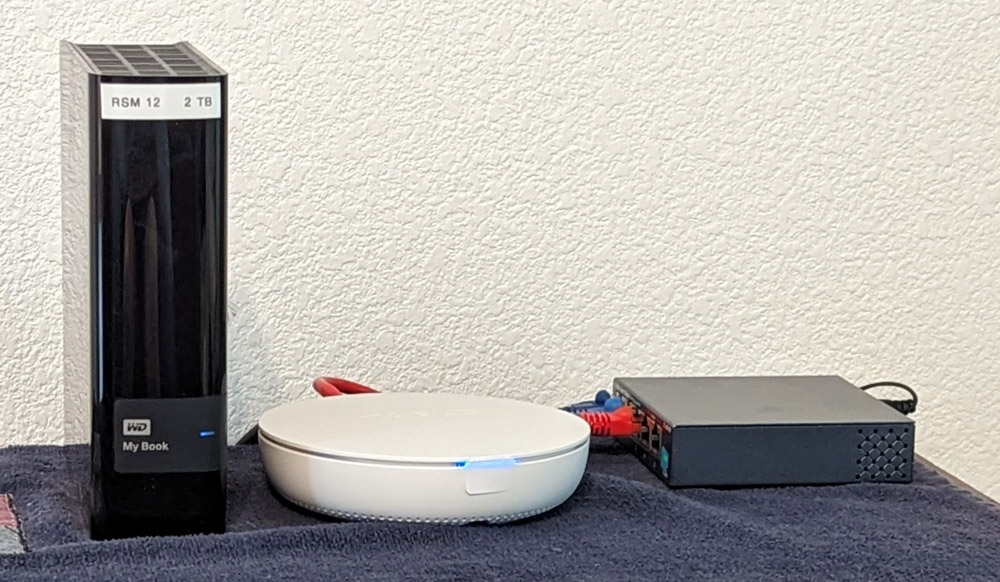
This is now my setup using the generation 4 Tablo. It is slightly smaller than the old one, but now it
is white and round. (Wow!?) It appears to work very much like the older one, but the new app has a flashier
look. The blue LED now has settings for on, dim, and off (the old one just on and off). But even the dim
is annoying as it faces out instead of up, and even in dim mode will require more filtering.
I also changed the Internet switch to one with much less obtrusive lights on it. The only
really bright one has been dimmed with 3 layers of masking tape over it.
Yes, I am still excited!
GO BACK
R. S. Mason August 2023